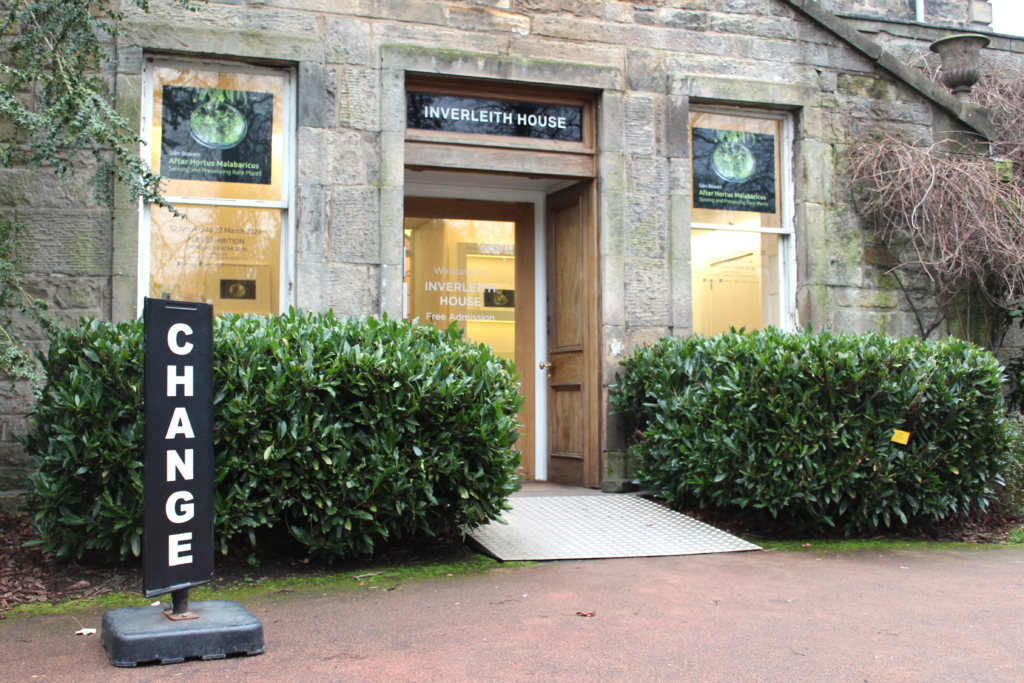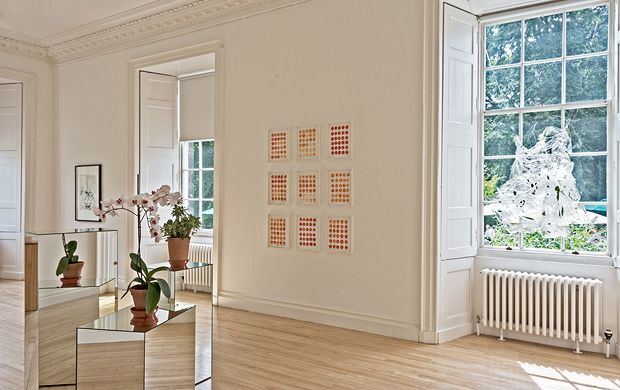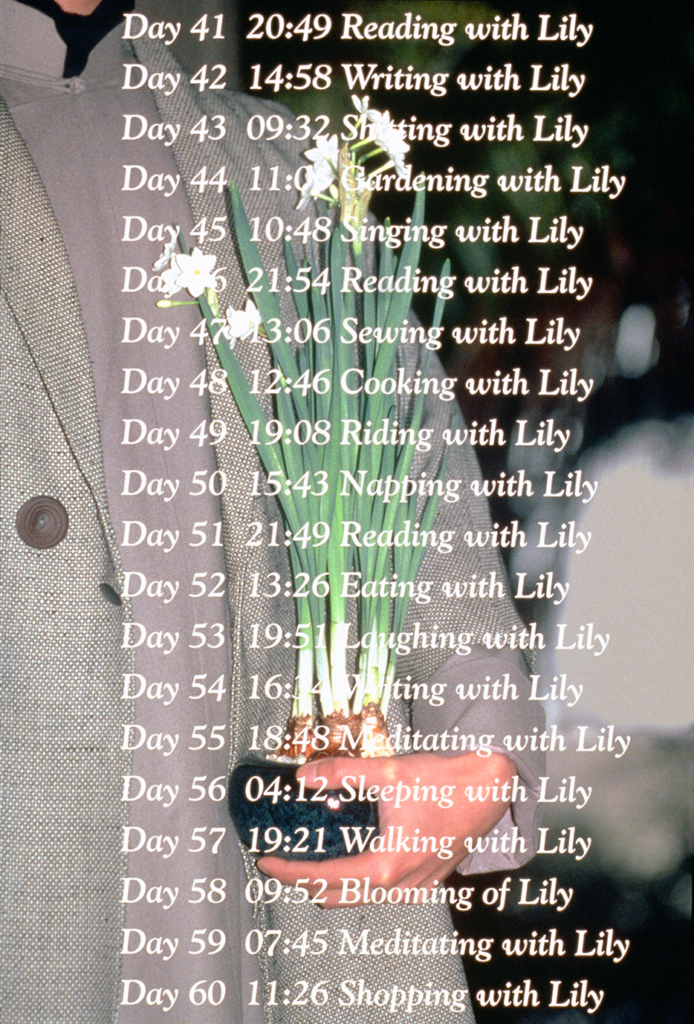A Change of Climate – How Inverleith House Was Saved From Permanent Lockdown

Florilegium – Saying it With Flowers
When Inverleith House opens its doors this weekend for Florilegium: A gathering of flowers, the exhibition marks a new beginning for the contemporary art space housed in the grounds of the Royal Botanic Garden Edinburgh (RBGE). The fact there is an exhibition in Inverleith House at all is something of a miracle, but more of that anon.
Florilegium features new and existing work by photographer and painter Wendy McMurdo, Barbados-based artist Annalee Davis, Edinburgh film-maker Lyndsay Mann and Taiwanese American artist Lee Mingwei. They will join over 40 established botanical artists for the first of what is planned to be a biennial response to the extensive plant collection collected by RBGE, a publicly owned and Scottish Government funded research organisation.
Works range from Davis’s suite of drawings, As If The Entanglements of Our Lives Did Not Matter, which references the artist’s Caribbean heritage; to Night Garden, a series of images crated by McMurdo under lockdown, inspired by the flowers growing in her studio (see below).

Mingwei presents two works; 100 Days with Lily (1995), and Invitation for Dawn. The first piece is a photographic portrait of the artist’s cultivation of a single lily from seed to death, while the second derives from Sonic Blossom (2013), in which a singer performs a song by Austrian composer Franz Schubert to a single listener. Mann’s contribution to Florilegium is A Desire for Organic Order, a cinematic essay drawn from a study of RBGE’s Centre for Middle Eastern Plants.
With a planned summer Edinburgh Art Festival exhibition postponed due to the ongoing Covid-19 pandemic, the opening of Florilegium – the word translates from the Latin as a book of flowers – also marks the beginning of Inverleith House’s own planned evolution. Initiated by RBGE’s new Head of Creative Programmes, Emma Nicolson, this will see the 18th century David Henderson designed building rebranded as Climate House.
This follows the lucrative Outset Contemporary Art Fund’s Transformative Grant awarded jointly to Inverleith House at RBGE and the Serpentine Galleries in London. The award marks the beginning of a partnership designed to explore the future of our planet through contemporary art. A manifesto for future artistic endeavours at RBGE, By Leaves We Live, was created by Nicolson in consultation with RBGE’s Arts Advisory Board, and outlines plans to ‘reimagine our programmes for the 21st Century explorer’.
Roots
Nicolson joined RBGE in 2018 following eight years as founding director of ATLAS Arts, the gallery and arts organisation based on the Isle of Skye. At RBGE, her appointment was initially as Head of Exhibitions. While this was for the venue as a whole, in an interview in the Herald in February 2019, Nicolson stated that “As far as I am concerned I have been employed to programme Inverleith House and rethink its future in relation to the challenging times for the world: thinking of climate change, and the science that is happening here that is cutting edge – this is rich material for artists to engage with.” More here.
Nicolson subsequently combined her role as Head of Exhibitions with that of Interim Head of Public Engagement from June 2019 before taking up her current tenure as RBGE’s Head of Creative Programmes.
Nicolson arrived at RBGE following the departure of Paul Nesbitt, the botanist and curator, who for thirty years had been Director of Exhibitions at Inverleith House. It was Nesbitt who instigated its internationally renowned contemporary art programme in 1986. During those three decades, Inverleith House showed major exhibitions by the likes of Andy Goldsworthy, Louise Bourgeois and Ian Hamilton Finlay, as well as younger artists such as Cathy Wilkes, Lucy McKenzie and Ciara Phillips. Inverleith House is known to have shown more Turner Prize winners and nominees than any other gallery in the UK apart from the Tate.
Prior to this, the House began its artistic life in 1960 as the original home of the Scottish National Gallery of Modern Art, before that institution moved to Belford Road in 1984. In 1992, pioneering film-maker Margaret Tait used the stairwell of Inverleith House as a location for a scene in her sole feature, Blue Black Permanent. By doing so, Tait not only seemed to recognise the importance of Inverleith House in contemporary art, but that it was itself a work of art.

Paving Paradise
All this is a world-class legacy of which any country can be proud. If RBGE’s Board of Trustees and senior management had got their way, however, that ongoing legacy would have ended on October 23rd 2016, the final day of the gallery’s 30th anniversary group show, the tellingly titled I still believe in miracles.
By this time, RBGE had issued a statement on October 18th saying that ‘Inverleith House will no longer be dedicated to the display of contemporary art, and RBGE is looking at options for the alternative use of the building’.
The statement was issued after plans to close Inverleith House as a contemporary art space were leaked to the press. Up until then, there had been no public announcement of the intended closure. This was despite the decision having been taken at a meeting of RBGE’s Board of Trustees two weeks earlier on October 5th. minutes-of-rbge-board-of-trustees-main-board-meeting-051016 At the time of RBGE’s statement, the minutes to the meeting had yet to be published.
While stressing that RBGE would continue to show art of all kinds across the Garden as a whole, the statement went on to say that ‘Through this change the organisation will remove the various inevitable financial risks attached to running a high-profile gallery.’
In an interview with the Herald newspaper on October 19th, 2016, RBGE Regius Keeper Simon Milne was quoted as saying that Inverleith House couldn’t “wash its face” financially.
This all sounded pretty clear cut. Inverleith House was no longer going to be used as a year-round contemporary art gallery, and it’s programme was to be scrapped because it couldn’t make enough money. Though never stated explicitly, once its status as an art gallery was removed, it looked like some kind of commercial cash cow was likely. Some feared a conversion into a boutique hotel, restaurant or wedding venue.
Where Have All The Flowers Gone?
Eleven months later, RBGE adopted a different tone. This was highlighted in another interview for the Herald, published on September 15th 2017.
This followed a U-turn by RBGE after the publication of a report by the Arts Working Group set up by the Scottish Government to attempt to salvage a future for Inverleith House.
In the September 15th article, Milne stated that he was “a bit annoyed that it’s been reported that Inverleith House was closing, there was never any intention to close Inverleith House to exhibitions. That’s how it’s been reported. We never said that.” Milne went on to describe the idea of Inverleith House being ‘saved’ as “a nonsense because it was never going to be closed. I think we have been misrepresented here.”
This followed on from a statement by Milne in The Art Newspaper that “There was a rumour that we were not going to do art anymore… that was never the case.”
Whether this was a case of professional amnesia regarding RBGE’s original statement, or a more calculated attempt to rewrite history and gaslight the public, isn’t clear. What was apparent by this stage, however, was that public pressure on RBGE had forced a rethink on its original decision to close down Inverleith House’s contemporary art programme.
This followed various strands of a loose-knit campaign opposing the closure, and calling for RBGE to reverse their decision. This included an online petition set up by arts journalist and political columnist Joyce McMillan, who said it was “outrageous that the RBGE management should seek to close it at just a few days’ notice, and without public consultation…” The petition attracted more than 10,000 signatories. An open letter opposing the closure was signed by more than 200 major artists and cultural figures from across the world.
On the final day of I still believe in miracles, several hundred protestors gathered outside Inverleith House for an event organised by the Scottish Contemporary Art Network (SCAN).
The same day, Product magazine forwarded 23 questions to RBGE regarding the proposed closure of Inverleith House’s year round contemporary art programme. After four years, despite repeated requests, these questions remain unanswered. At various points, email responses from RBGE claimed they had been answered, though when asked to provide details failed to respond. Despite their claims, a later email from RBGE contradicted the claim, highlighting what they called the ‘impossible nature’ of the questions. Details of this and other twists in the saga can be found here.
Meanwhile, Scotland’s arts funding body Creative Scotland issued their own statement, declaring the body to be ‘very disappointed’ at RBGE’s decision, and that the importance of the gallery “cannot be understated and its loss will be profoundly felt.”
In artnews.com, former Herald art critic Clare Henry quoted Turner prize-winner Douglas Gordon, who exhibited at Inverleith House, and who described the closure as “the most myopic decision that any forward-thinking administration could possibly make. Bang goes the Enlightenment – roll on the Dark Ages!” In the same article, veteran arts champion Richard Demarco described Inverleith House to Henry as “a well nigh perfect example of a building expressing the principles of the spirit of the Scottish Enlightenment. Such a building should continue welcoming all those whose lives are enriched by the visual arts.”
Milne, however, defended the closure, telling Henry that “We looked at the budget and concluded we were not prepared to continue the risk of underpinning the art gallery at the expense of our core programmes of botany and horticulture.”
City of Edinburgh Councillor for Inverleith, Lesley Hinds, spoke out against RBGE’s actions while in Westminster, SNP MP George Kerevan to table an Early Day Motion opposing the move. The motion, set down on November 23rd, noted ‘with concern the closure, without adequate consultation’ of what Kerevan called ‘one of Edinburgh’s premier public art galleries…’ Kerevan went on to call ‘on all parties to work together to preserve Inverleith House as a home for the arts.’ Sixteen of Kerevan’s fellow SNP MPs signed the motion, including Deirdre Brock, whose Edinburgh North and Leith constituency includes RBGE within its boundary.
At Holyrood, RBGE comes under the jurisdiction of Roseanna Cunningham as Cabinet Secretary for Environment, Climate Change and Land Reform rather than Fiona Hyslop as Cabinet Secretary for Culture, Tourism and External Affairs. Hyslop nevertheless expressed concerns on social media, indicating her intentions to meet with RBGE and Creative Scotland to seek a way forward.
Under the stewardship of Professor Chris Breward, then Principal of Edinburgh College of Art, the Arts Working Group’s report that resulted from the various interventions made several positive recommendations, which set down some of the groundwork for the current initiatives. The report was also diplomatically critical of RBGE.
Contrary to its claims of Inverleith House not being able to “wash its face”, the report pointed out that the Arts Working Group “believes that the RBGE is in a position of strength compared to many other arts organisations…” .
Having been upbraided in such a way, one might reasonably expect those responsible to put their hands up and admit to what at best could be described as an error of judgement. Rather than offer up any show of institutional humility, however, only the claim of being “misrepresented” has ever been forthcoming.
That was back in 2017. Since then, with RBGE’s planned closure of Inverleith House as a year round contemporary art space discredited, various exhibitions have taken place. While some have been noble attempts to maintain the venue’s status, others more resembled wheezes dreamt up over cocktails at Edinburgh New Town society do’s. After these limbo years, Florilegium looks set to revitalise a venue that came close to being lost to the world.

Seeing the Wood for the Trees
Arguably the roots of RBGE’s decision to close down Inverleith House’s year round contemporary art programme date back to Creative Scotland’s decision to turn down RBGE’s 2015 application for Inverleith House to become a Regularly Funded Organisation. While the gallery programme had been supported by Creative Scotland with annual funding from the Flexible Funding and Open Project streams, RFO status over three years would have given it a certain level of financial security to plan ahead.
Creative Scotland funding had been used by RBGE to commission A Future for Inverleith House, a 55-page report produced by consultants, Kelly and Co. RBGE initially resisted publishing the Kelly report, before releasing it in redacted form following a Freedom of Information request. While the report proffered various proposals, at no point did it suggest Inverleith be closed in any way.
Interestingly, the minutes of the Board of Trustees October 5th meeting describes A Future for Inverleith House having been funded by Creative Scotland ‘following their move from providing Regular Funding to Open Project Funding’. While the report had been funded by Creative Scotland, as already noted, Inverleith House had never been a Regularly Funded Organisation. This was made clear in a correction outlined at the end of my own report in the List magazine on October 19th 2016, in which I had initially made the same error.
In hindsight, while one might be forgiven for misinterpreting the at times labyrinthine by-ways of arts funding terminology, this minute looks carelessly phrased and potentially misleading. Had it been more precise, the protracted drama that followed regarding Inverleith House might have been avoided.
Night of the Long Grass
There have been other changes at RBGE since Nicolson’s arrival. Both Head of Engagement, Dr. Ian Edwards, and Chair of the Board of Trustees, Sir Muir Russell, have left their roles. Russell is the former senior civil servant who was the first Permanent Secretary to the Scottish Executive during the significant overspend on the construction of the Enric Mirales designed Scottish Parliament building in Holyrood.
Russell’s many other roles include a six-year stint as Principal of the University of Glasgow, where he received criticism for the handling of the 2006 lecturers’ strike. More recently, in 2011, Russell was appointed Vice Chair of Glasgow School of Art’s Board of Governors, stepping down in 2018 having completed the maximum term possible. Russell
While Russell and Edwards have departed RBGE, for now at least, Regius Keeper Simon Milne remains. Given his claims that Inverleith House was unable to “wash its face” and that RBGE’s proposed closure of the venue as a year round art space had been “misrepresented”, for how long remains to be seen.
I Can Hear The Grass Grow
Florilegium opens at Inverleith House almost four years to the day since the 30th anniversary I still believe in miracles exhibition closed. Such symmetry may be loaded with symbolism, but the unedifying and protracted spectacle that came inbetween might look to some as so much ancient history. It remains crucial, however, that an attempt at board and senior management level to close one of Scotland’s great public art spaces without any notice or apparent consultation isn’t swept into the long grass. It is vital as well that a prolonged refusal by those in office at RBGE to be called to account for their conduct is not forgotten.
What RBGE’s board of trustees and senior management attempted was cultural vandalism, plain and simple. As long as those responsible for that are still in office, an environmentally unfriendly cloud will hang over both its reputation and any future ventures, no matter how worthwhile. If RBGE can attempt to close down an internationally renowned art space without consultation or transparency regarding their decision once, after all, what’s stopping them having another go?
This is something both Emma Nicolson, RBGE’s Arts Advisory Board and the organisation’s new Chair Dominic Fry might wish to consider. Nicolson and those that follow in her wake need a guarantee that, however Inverleith House is branded, they are enabled to pursue an artistic vision without interference from those more interested in money than art.
Inverleith House has showcased the best in contemporary art from both home and abroad for more than half a century. RBGE’s failed attempt to close it down in 2016 nearly ended that as abruptly as one might stamp on a flower. Such an occurrence must never be allowed to happen again. Long may Inverleith House blossom.
Florilegium: A gathering of flowers, Inverleith House, Royal Botanic Garden Edinburgh, October 16th-December 13th 2020, from 10.30am. Last admission to the exhibition in October is 4.15pm, and in November and December 3.15pm. Entry to the Garden and exhibition is free, but under social distancing regulations must be booked in advance. Time slots can be booked at https://www.eventbrite.co.uk/e/royal-botanic-garden-edinburgh-tickets-from-october-16th-tickets-124977951417

Following the award of the Outset Transformative Grant, Inverleith House will be transformed into Climate House as part of a three-year project. Climate House will welcome artists from Scotland and around the world to showcase work that encourages conversations about life on earth and expand our understanding of biodiversity and our place in the world. The first exhibition